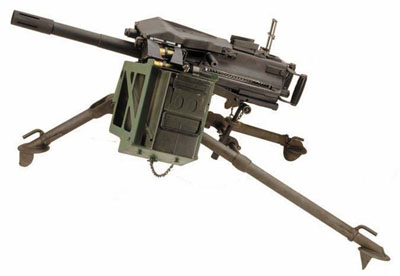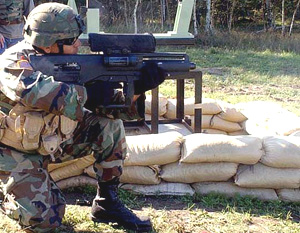Smart Weapon System
These ideas are an extrapolation of current experimental smart weapons into Warhammer 40000. It is my vision of the Bolter as a 'smart weapon' linked via the Black Carapace into the Machine Spirit (Covenet) of the power armour which forms a symbiotic relationship with the Space Marine's mind, and the suits sensors, peripheral detectors and comms. All combined this forms a sophisticated targeting, and weapons management, system. A DNI or Direct Neural Interface with machine spirit co-mind. To the Space Marine they are literally one with their weapons, it is an extension of their will and controlled with their intent. This is quite advanced by sci-fi standards.
= Philhammer - Unofficial 'fan fiction' =
Space Marine Issue Bolter
The Space Marine issue Bolter is the most sophisticated line of Bolters developed by the Adeptus Mechanicus. Although the basic feature are the same are many Bolters issue to other factions within the Imperium, the Space Marine issue Bolter is designed to integrate with the Space Marine issue Power Armour, and make use of the Black Carapace implant as a interface between weapon, armour and mind. The other striking feature of the Bolter is the size of the thing, it is literally twice the size of a regular issue Bolter (such as those used by the Arbites and Sisters of Battle). It is heavy and packs quite a punch with it's oversized Bolts.
Bolter Pattern: 'Philhammer' 😀
The Philhammer pattern was developed, and produced, on the Forgeworld of 'Portent' (Portent is the old forum name of WarSeer). The are two types in current production: the gun, and the pistol.
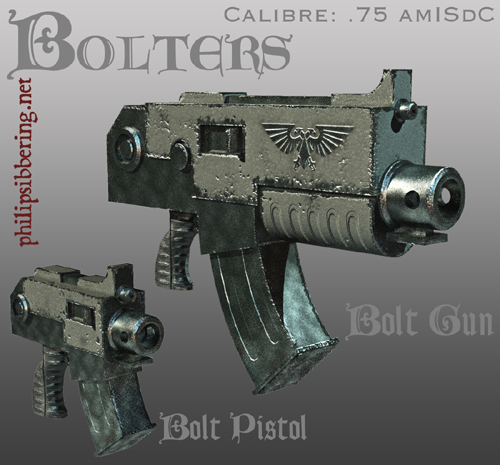
Stats (Gun)
Weight: 6 ACIS* St [Stone] (guesstimate conversion 35kg similar to Mr 19)
Calibre: .75 ACIS* dC [deciCubits] (guesstimate conversion from High Gothic units: 35-45mm, i.e. similar to 40mm grenade).
Cartridge: x3.5 calibre
Action: Photonic Pulse Ignition (PPI), direct drive mag-lock ejector flow through (reason port is high).
Cyclic Rate: 2,000rpm :O (1,800-2,200 depending on model)**
Muzzle velocity: 100 ft/s (.45 pistol is 800), increasing to 4,000 ft/s (Bushmaster Autocannon) at 80 yards
Effective range: 2,000 yard, 8,000 yards max
Feed system: Induction Mag (it sounded kwell!).
*Adeptus Mechanicus certified Imperial Standard
** see G11 for 2,200 RPM (salvo) rifle! All explained under mag-lock ejector 😉
Stats (Pistol)
Weight: 1 ACIS* St [Stone] (guesstimate conversion 5-6kg similar to ?)
Calibre: .5 ACIS* dC
Cartridge: x2.5 calibre
Archetype
The Bolter is not an assault rifle or sub-machine gun. In modern terms it has more in common with the 40mm Mk 19 automatic grenade launcher and the shoulder fired 25mm XM25, blended with an RPG such as the 66mm M72 LAW or 64mm RPG-18 and finally a dash of some gyrojet technology. The AA-12 is another one to look at, here's a Youtube clip of it in action: AA-12 World's deadliest shotgun! Keep an eye out for the frag 12 that turns up at 4:30.
Mk 19. Image taken from Wikipedia (Copyright: Public Domain). |
XM25. Image taken from Wikipedia (Copyright: Public Domain). |
Bolter Overview
The Bolter is the primary tactical weapons system of the Space Marines. It is a highly rugged and forgiving weapon that rarely breaks down and operates in most weather and atmospheric conditions. It will fire under water and in the vacuum of space (with limited kickback), and if very resistant to dirt contamination. It is also a very cool weapon and hard to spot with infra-red.
Chassis
Ablative heavy armour bolted onto a Cermet monocoque chassis with standardised layout. Designed to take modular armoured internal units and snap ins. The T1 (type 1) monocoque is the same throughout all the Space Marine chapters and is supplied by the Adeptus Mechanicus as is. Even custom Bolters and Combi-weapons based on Bolters use the Type 1, and even the earliest Bolters used this (but with a different modular ammo feed and barrel configuration, and lacking the ablative armour plating - all added later).
Firing Mechanism - maglock ejector
There are surprisingly few moving parts within the Bolter. The feed is a 'trough and trough' track with 'maglock'. The only moving parts are the spring, ammo and the blocking lugs. Even the ignition system has no moving parts and is a (coded) photonic pulse.
Overview
- The bolt is pushed directly into the breach via the magazine spring.
- The bolt's movement is stopped by four protruding 'lugs' in line with the upper part of the barrel. These lugs can be retracted into the wall of the breach to allow a clear upward path. An electronic magnet is used to engage and retract the lugs. The bolt stopped by these lugs is said to be 'locked', and as they are controlled by a magnet, the system is referred to as a 'maglock' (there is also a variant where the lugs are magnetised themselves and attract to a metal sleeve, snapping it into place).
- Once locked, the 'full sleeve' of the bolt actually forms part of the barrel.
- A photonic pulse* initiates the bolts kicker charge**. This kicker charge is very low compression (similar to compressed air), therefore the sleeve alone will more than suffice as part of the barrel.
- The bolt leaves the weapon, and once clear ignites its gyrojet, which powers it to the target.
- The fire control system of the bolter then releases the maglock***: the numbs retract to clear a upward path to the ejection port.
- The spent sleeve is pushed up and out of the ejection port by the next bolt, which is being pushed up by the magazine spring. As the maglock is turned back on to catch the next bolt, the lugs pop back out, and this also has the effect to force the spent sleeve out of the ejection port. (This ejection of the spent sleeve through the top of the barrel explains the high ejection port on the bolter and why it is called a 'through and through' track system).
- The new bolt is brought to rest by the re-engaged maglock lugs.
- Some bolters use kinetic energy (mag-hammer) to ignite the charge.
** Some bolts do not have a kicker-charge are are basically a 'fully sleeved' gyrojet.
*** Some bolters use a mechanical gas blow-back system to release the locking lugs instead of a electronic maglock.
This streamlined system, lack of moving parts, and low temperature kicking charge allows for a phenomenally high rate of fire compared to modern day mechanical designs. Also, coupled with the very low kick of a bolt ammunition, it allows for very good control at high firing rates 😛
Notes: It should be noted that it is rare for a Space Marine to fire more than one (modal) bolt, and when they do it is three. The Space Marine can empty a bolter is under a second, but would only do so against a super Nids or some other monster (and there are better weapons for this role). The real win of the design is smooth fire, lack of climb during quick bursts and single shots. It can go full auto but that is a 'rookie' mistake in Bolter-Fu .
Fire-control: as fire rate is control by electronics, the rate of fire is variable, and the marine can set the timing on the fly. Usually 400 RPM is the minimum used, but it can be set as low as 1 RPM. The max is 2,000 RPM (this includes safeties and is artificially limited).
Machine Spirit
Text (see below) 'Artificial Bio-Photonic Computer'
Power
The Bolter has resource batteries to run its reprocessing systems but it draws its main power from the Space Marine, via the photonic bridge. It is possible for a Bolter's Machine Spirit's biological elements to 'die', though in lower power mode it can take a while (hibernation).
Space Marine and Bolter as One.
The Bolter and Space Marine are connected to each together via the Marine's Black Carapace. This link allows the Space Marine communion with the 'Machine Spirit' of the Bolter. The Space Marine feels and acts as if the Bolter is an extension of his own body, he sees what his Bolter system sees, he feels its status, and it responds to his intent. In ancient times becoming 'as one with your weapon' was the highest achievement of skill, the Space Marine takes this a literal step further and becomes 'one with the weapon'.
Covenet [Coven-net]
The Cortex, an artificial bio-computer, is the 'machine spirit' of a Marine's Power Armour. Together with other Machine Spirits from the various subsystems (Bolter/ Backpack/ Comms) they form a Pantheon of Machine Spirits known as a 'Covenet'. The name derives from 'coven' and 'network'. The technology used in such a device is considered sacred by the Adeptus Mechanicus and referred to as 'archon-tek' (from the Greek word for ruler: 'Archon' as in the class of 'archon technologies' or 'ruling technologies', not to be confused with 'archaeotech' and variants such as archo-tech, archo-tek, archaeotech which refers to ancient Dark Age technology in general) which is the highest form of technology. The Covenet is an auto-servitor of a sorts that runs all aspects of the suit; from neuro-fibre bundle musculature to life-support, and even 'smart' peripheral sub-systems.
The Head of the Covenet's Pantheon is the Space Marine himself (analogous to 'Zeus' (Emperor ref?)) linked to the Power Armour's Cortex via a DNI and Black Carapace.
Part of the Autosense system
DNI - Direct Neural Interface
The DNI is part of the upper order of the Black Carapace's Network. This interface allows the marines mind to link to the Cortex of their Power Armour. The Interface is made from electrografts, 'bio-plastic web-chips' implanted on the inner surface of the skull, with photonic-connectors cut thought the skull to link into sockets inserted into the Black Carapace. These sockets are located externally at the back of the Space Marine's skull. The web-chip's tendrils burrowing deep into the brain, linking into the natural neural net of his mind.
To the Marine this system is totally transparent: the marine sees, hears, smells, even feels, with the armour's auto-senses, he simply knows the current status of the amour's systems, and a mere thought controls all its functions.
Black Carapace
Further to the DNI, the Black Carapace skin implant links into the Power Amour at key points on the body of the Space Marine to relay nerve signals, acting as the armour's 'spinal cord' of a sorts, and allows the Power Armour's perfect matching of the Marine's movement.
To the Marine the armour do not encumber him, it feels like his own skin, as it part of his own body.
Peripheral Sub-Systems
The standard issue Space Marine Bolter is a 'smart' peripheral sub-system, blessed by the Adeptus Mechanicus with a Machine Spirit. This means the Bolter's fire-control cogitators and sensors can link into the suits system hierarchy as a sub-system via the Machine Spirit within the Bolter. The direct system connection is made as soon as the Marine picks up the Bolter. Photonic pads in the palm of his hand match similar pads on the grip of the Bolter. These pads form a closed bridge between the two systems. All signals from the Bolter's Machine Spirit are routed via the Black Carapace, which is essentially the Power Armour's nervous system, to the DNI. All edicts from the Marine to the Bolter follow a similar route.
Sentient
The Machine Spirit within the Bolter is a bio-photonic cortex, imprinted with a mind patterned after a higher order avian such as a Raven (though other animals are know to be used, such as wolves), though modified to suit the purpose. This 'mind' provides advanced optical based recognition enabling the Bolter to recognise a face, and will recognise its chapters markings, other Space Marines within the squad to which its bonded Space Marine is a member, and the Adeptus Mechanicus. The Bolter can only see, but once linked to the Marine it becomes aware of the bigger picture and gains tactical information and the location of other Space Marines. The recognition and awareness means the Bolter will actively avoid 'friendly fire', and is so quick that in a sweep it will just 'skip' a round when a friendly is detected.
Bonding
The recognition ability is also part of the security system in all Bolters. The Machine Spirit once 'pair bonded' to a Marine will recognise that Marine. If a Bolter 'likes' a Marine is will consent to the life bonding. To a Marine, his Bolter is much like a 'pet' (tamagotchi :P), though it is not seen as subordinate, more a guide and partner, part of the pantheon of Machine Spirits that form the Covenet.
A Bolter may reject a Space Marine and it is not uncommon for a Bolter to refuse bonding. However if it does bond it will bond until death (Bolters will recognise its bonded Space Marine's death, and if separated at the time of death may need to 'see proof'), and after a period of mourning may accept a new bond, or may not. Bolters of chapter heroes can become fussy about who they accept. However, there are records that in time of dire need that Bolters will accept a temporary bond 'for the good of the chapter', and it seem to be an emotional response rather than a logical response.
Bolt
Source quote from Wikipedia: “Rocket-powered missiles are known as rockets if they lack post-launch guidance or missiles or guided missiles if they are able to continue tracking a target after launch. Cruise missiles typically use some form of jet engine for propulsion.” Well that sorts out what rockets and missiles are in today's terminology, but what is a 'bolt' (aside from a crossbow bolt).
Third Form
A bolt is not a missile as it will not track post-launch (unless using a long range sniper smart round – but that's an exception) neither is it a simple 'dumb' rocket either. A Bolt is a third form, a rocket that is pre-launch programmable, that allows it to change the way is acts in combat.
Construction
This is an overview of the standard Space Marine issue bolt. It is a highly versatile munitions and fulfils are variety of tactical objectives. In order to archive this versatility it is unlike other ammo with similar uses, such as grenades launcher and RPGs. It is also a fully sleeved design.
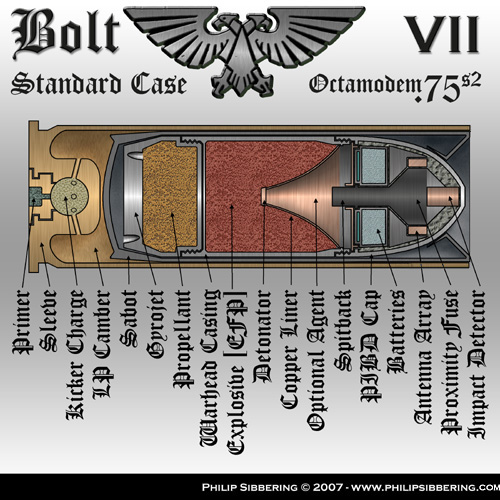
Case
The Bolt is a fully sleeved design. Unlike traditional rounds the sleeve actually forms part of the barrel in the 'through and through' feed system. There is not part of the projectile that protrudes beyond the sleeve. Combined with the packing sabot the bolt is well protected.
Sleeve
Outer casing. All Space Marine issue bolts (including specialist ammo) utilise the standard (brass effect) sleeve with kicker charge and signal relay.
Kicker
The initial launch system is similar to that used on modern impact grenades, and the bolt handling within the Bolter is very similar to modern grenade machine guns (belt feed from box). This initial kicker is to clear the bolt from the muzzle. It is a very low temperature propellant, there are variants that even use compressed air!
Sabots
As the various bolt types (standard and specialist) have different shaped profiles, a packing sabot is used to encase the bolt to standardize the profile before being fitted into the standard sleeve. This allows any specialist ammo with an unusual profile to be fired from the Space Marine issue bolter without modification, and protect the bolt form the kicker charge at launch.
Note: The Packing Sabot is not used in the same way as those used in modern tank penetrator rounds.
Propulsion
The standard bolt used by the Space Marines uses a gyrojet, though other options are available for specialist missions, including a 'torpedo' version for underwater missions which has greater range.
Gyrojet
Once clear of the muzzle, and depending on the mode the Bolt was launched with, the main Gyrojet rockets may engage to power the Bolter towards it's target (in this respect it is very similar to a Rocket Propelled grenade launcher). In flight stabilization is achieved via spin imparted by small rocket ports angled in such a way as to rotate the bolt along it's axis. It should be noted that the gyrojet uses a smokeless powder and leaves no trail, though after a second of flight it will heat up and become highly visible to infra-red based vision systems which if coupled with automated firing system could calculate trajectory and track back and target the firing point (though Space Marines are smart enough to move after firing (fire-dodge).
Warhead
Bolts come with a variety of possible warhead, the one describe here is the most commonly used in tactical operations.
- Payload: Dual explosive warhead consisting of a primary solid explosive with a conical hollow containing a secondary low pressure explosive. If the primary solid explosive is detonated first it effects a shaped charge explosion much as a HEAT round. If the secondary slow burn gas explosive held in the cone is detonated is mushrooms the shaped charge's liner thus nullifying the shaped charge's effect if the main explosive is then detonated. This results in an airburst similar to a fragmentation grenade.
- PIBD (Point-Initiating, Base-Detonating): It is a piezoelectric based fuse.
- Proximity Fuse: Radio frequency sensing (Mass reactive), powered of the batteries.
- Core: This is the main controller and links the two detonation systems and controls the Gyrojet switch. It is embedding with the Oscillator-Detector Amplifier and is attached to the Deuterium Thyratron behind the Annular Firing Condenser. The Core is often named after the gas filling the Thyratron, in the standard Space Marine bolt this is a 'Depleted Deuterium Core'.
Note of 'Depleted': Deuterium is rendered from a direct enrichment process, which produces deuterium and tritium from hydrogen. The tritium is removed, leaving the deuterium which is referred to as depleted (having the tritium removed). This is similar nomenclature used to describe Depleted Uranium. For a more detailed look (for those who are driven nuts by this) please view;
Bolt Modes
Bolts are not guided missiles but the are 'modal rounds' and can be programmed before firing to perform various functions in a tactical situation. The Bolter also has a range of firing solutions that can rapidly program each bolt fired within a burst to act in a different way. This gives the Space Marine great versatility in the field.
The Bolts are switched to various modes via communion with the Archo-Covenet (Machine Spirit). Each mode changes the behaviour of the Bolt in combat, enabling the Space Marine to dynamically adapt to the threats they encounter with a single weapon. Judicious uses of the modes and tactics employed in their use can give the Space Marine a huge advantage in the field over most opponents they encounter.
Bolt Modes Octamodem Bolt (Space Marine Standard)
The following is the 'Octamodem' Bolt with eight mode states. Space Marine carry around 180 of these bolts as part of their standard kit on tactical operations.
Mode 0 (Storage)
Can only be armed with correct coded signal from authorised Bolter. The Bolter can only authorise if it receives the correct activation commands from is designated Covenet and is attached via a live feed and confirmation of vital life signs has been confirmed. This is a double safety measure as both Bolter and ammo is rendered inactive unless a Marine is present.
Mode 1 (HEAT: High Explosive Anti Tank)
Kicker - Enabled/ Gyrojet array - Enabled/ PIBD - Enabled/ Proximity fuse - Disabled/ Auto destruct - Enabled.
- At short range (up to 50m) the bolt defaults to mode 1 until it picks up sufficient speed to cause impact damage through kinetic energy, it then takes on a programmed intent of the shooter if different from mode 1.
- The bolt detonates as a shaped charge on contact and is effective against heavy armours acting as an RPG (rocket propelled grenade). However they are ineffective against 'electric armours'.
HEAT Performance (approx)
Mode 1 can punch though 4" (100mm) of RHA (Rolled Homogeneous Armour), 2' (600mm) of pine logs, 32" (800mm) of concrete block, 6" (150mm) of reinforced concrete, 4' (1200mm) of sand bags, around 2" (50mm) of base ceraforms. All these figure are consistent over the entire range of the weapon, and max powered range of 1km/ 1000m/ 3,280 feet.
Vs Modern armour
The bolt would slice through most APC armour, including the M113's 12-38mm aluminium armour (aluminium tends to vaporise when hit with HEAT rounds) and the M2/M3 Bradley even with urban armour upgrades. The Bolt will not penetrate the main battle tank armour such as Chobham Armour found on the Challenger 2 and Adrams M1 (guesstimate equivalent of 24" of RHA on main facings). However, the Bolt would destroy tracks, hatches, and other vulnerable areas so a Marine would gain access (disable, close, access, finish with mode 2 to interior).
Mode 2 (Direct HEAB: High Explosive Air Burst)
Kicker - Enabled/ Gyrojet array - Enabled/ PIBD - Disabled/ Proximity fuse - Enabled/ Auto-destruct - Enabled.
A HEAB (High Explosive Air Burst also see: Air Burst) anti-personnel mode designed to take down a group of lightly armoured dispersed targets over a wide area, for clearing confined spaces such as buildings, and areas too small for a Marine to enter. The combination of the proximity fuse/ auto-destruct being enabled allows the Marine to judge the distance to the centre of a group and allow the bolt to optimise timing/ placing.
For an example of this airburst function and it's possible uses see this Youtube video on the XM307
AIR BURST Performance (approx): Vs unarmoured human: Casualty Radius: 500'/150m, Kill radius: 20'/ 6m.
Mode 3 (Indirect HEAB (Mortar))
Kicker - Enabled/ Gyrojet array - Disabled/ PIBD - Disabled/ Proximity fuse - Enabled/ Auto destruct - Enabled.
- Airburst as mode 2.
Mode 4 (Mine)
Kicker - Enabled/ Gyrojet array - Disabled/ PIBD - Disabled/ Proximity fuse - Delayed*/ Auto destruct - Disabled*
The proximity fuse is not armed immediately but on a delay timer. The bolt lands a then the proximity fuse is armed. Once armed it takes a reading and sets that to the baseline. Any new mass that comes into close proximity with cause the Bolt to detonate as an airburst. Bolts do not make effective long term mines as they lay on the surface and are easy to spot with the naked eye, they emit signals that can be detected with basic scanners, and have a relatively short life due to battery drain. They are used in active combat, the tactic being to block escape routes (lob them in behind an enemy) and drive routing enemy into this temporary Bolt minefield.
Mode 5 (Baton)
Kicker - Enabled/ Gyrojet array - Disabled/ PIBD - Disabled/ Proximity fuse - Disabled/ Auto destruct - Disabled.
This mode only works with rubber capped bolts, which the Marine variant does not have. In this mode the Bolt is inert and fired using only the kicker charge. Considering the mass of the bolt this is still results in a substantial an impact and quite capable of disabling a person. Comparable to modern day 'rubber bullets'.
Mode 6 (delay)
Kicker - Enabled/ Gyrojet array - Disabled/ PIBD - Disabled/ Proximity fuse - Disabled/ Auto destruct - Enabled.
Similar to mode 4 (mine) but on a timer. The Marine can set the timer to what ever he chooses. Common timings use an auto-burst of four Bolts, 1 second apart and each time set for one second less. This means all four Bolts will explode at the same time.
This mode is also similar to the modern 'smart grenade'.
Mode 7 (agent)
Kicker - Enabled/ Gyrojet array - Disabled/ PIBD - Disabled/ Proximity fuse - Disabled/ Auto destruct - Disabled*
The shaped charge cavity is filled with a biological or chemical agent. The mode 7 detonates the cap charge (safety disable) which releases the agent.
Often used with an instantaneous hallucinogenic compound for Bolter auto-firing pattern: 'sixes and sevens', or in the case of Nurgle Marines (Death Guard) bio-toxins.
Note: If the Bolt is detonated normally it will vaporise the agent. If the bolt is tampered with and the cap removed the agent will be released (a little gift from the Adeptus Mechanicus for attempting Techno-heresy).
Note: Mode Sept is where the low Gothic 'septic' is derived.
Mode 8 (Standby)
When a magazine is loaded into the Bolter, and if Bolter issues the correct codes and is recognised, the Bolts are armed by going into mode 8. While in mode 8 the Bolts are monitoring for updated instructions and draw power from the Bolter. A break in power disarms the Bolts and they drop back to Mode 0.
Notes: In light of the added XM307 video link under Mode 2 (above), the Mode:8 function may be revised and changed to 'kinetic penetrator' mode for taking on large bio-targets and weak (brick/ concrete) buildings at long range. This is to replicate .50 role.
Art of the Bolter
The Space Marines are trained to become one with their weapon, and this skill and ability is considered an art (martial art).
Terminology of live Bolts
Bolts are bolts until they are fired.
Once fired a numerical prefix is added to the bolt to describe what mode the bolt is in. A bolt that has been fired and is in Mode 1 is called an Unobolt, Mode 2 a Duobolt, Mode 3 a Tribolt and so on. This is easier to write in fiction, and emphasises the differences in effect (think of Judge Dredd's lawgiver with its different bullets).
Bolts with eight modes, armed, and in the mag are referred to as 'Octobolts'. They are technically only 'bolts' when unarmed. In Space Marine culture 'Octo' means 'standby' (basically arm bolts for war). Usually shortened to 'Oc' (sound like a bunch of Gorillas? :D)
More than a name: The modal names for bolts are always capitalised due to 'machine spirit' associations. This also distinguishes it from a regular used of a word, which is more apparent with chapter variants.
Variants: The terminology is not set, many chapters use their own code words, like 'Lance' for Unobolt, 'Shot' for 'Duobolts and 'Hail' for Tribolts, along with nick names like 'Snappers' (mine) and 'Knuckles' (baton - 'black-eyes' as in 'popped a knuckle in his head').
Tactics of Mode
Although the Bolter has an astonishingly high rate of fire, almost three times that of a modern day assault rifle, it is rare for a Space Marine to unleash three bolts at a time let alone a whole mag! Generally one targeted, optimised bolt will suffice at any given moment.
'Nids: With massed enemies, the airburst modes of Duobolts and Tribolts are particularly effective to mow down Termigaunts, but the airburst is also good for stunning the larger beasts before nailing them with an Unobolt.
Close Combat
Ammo Stores
Space Marines store Bolt mags (magazines) in an storage area underneath the backpack, in the small of the back. Although Bolter mags are heavily armoured, the storage area offers additional protection on all sides via the backpack, shoulder guard and torso armour. This is to ensure the Mags are in good condition and always usable.
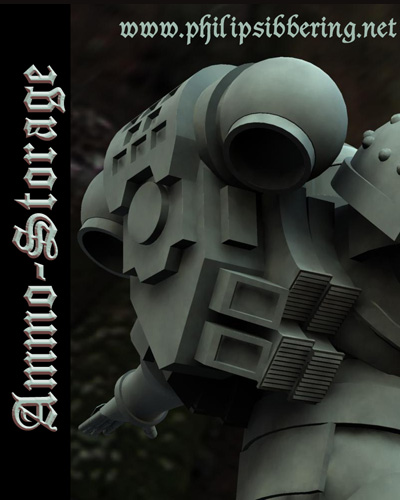
Ammo Management
Marines organise their ammo as a collective;
Inventory
A Space Marine usually enters combat with one mag loaded into his weapon, and 8 (eight) more mags in stores. Each mag holds around 20 bolts (180 bolts total).
Cooperative
The mags are placed in the counter-intuitive position due to the highly cooperative way Space Marine fight as a unit, and they operate is known in modern lingo as a 'buddy system' for ammo storage.
In the buddy system, Space Marine take mags from the brother in front of them. So while a Marine is fighting up front another is loading up behind and in cover.
Tracking
The Covenet keeps track of inventory and alerts all brothers as to who has mags, and how many, and will direct a Marine where to resupply to even out stores. The combined Covenets are even smart enough to take operations into account and optimise the system to ensure that all the Space Marines have access to the mags when need (even noting Space Marine performance and predicting ammo usage in relation to blips).
As with all Covenet systems there is no HUD, the Space Marine 'just knows', as if it was a memory recalled.
Drum Box
Link-less feed system. The areas used from storing magazines can take another type of magazine called a drum box. With the drum box the 8 magazines are replaced with a single ammo drum box magazine. Unlike the regular magazines the drum box is not snapped into the Bolter directly but instead has an armoured feed-track linking it to the Bolter.
Note: This is similar to the feed-track used in the Heavy Bolter (not a normal human sized Heavy Bolter have the same track as the Space Marine Bolter, but with a 'liner', in may ways the Heavy Bolter a stripped down Space Marine Bolter with the Drum Box).
Capacity
The drum and track hold 250 bolts (80 in feed-line).
Pros
The benefit of the system is that a Space Marine does not have to change clips as they chew through the ammo, and can unload the whole drum box all at once. This give a very high level of fire-power, and is effective at dealing with surprise attacks, breaking assaults, and buying enough time for backup to arrive.
Cons
The disadvantages are the slow replacement of a spent drum box, and the vulnerability of the feed-track, and restrictiveness of the connected feed-track when in close combat, and most importantly the (slightly) lower capacity. It is because these disadvantages that the drum box is not deployed on missions, and combined with the advantages, it usually only turns up in lone Space Marines on (lone) sentry duty, where they are spread thin but with mobile backup.
Heavy Bolters
The Heavy Bolter issued to the Adeptus Astartes uses a larger calibre that their Standard Bolter, has a more powerful kicker charge gyrojet. It is also fielded using the 'drum box' (see above). It has a slightly lower maximum rate of fire that the Standard Bolter, but due to the greater amounts ammo is more likely to actually be used in full auto (this leads many observers to conclude the Heavy Bolter is faster firing, but it is just the way they are used by marines). The Heavy Bolter is ideal for smashing strong points, buildings and light vehicles. Space Marines make good use of the to rapidly take out hardened positions within STC bunker complexes (Ecorium) or mow down hordes of xenos like 'Nids.
Modern Equivalents
There are no directly comparable weapons systems, but the easiest way to figure out it's power is to think of a Mr19 automatic grenade launcher but using 60-80mm grenades with rocket motors instead of its 40mm. This gives each heavy bolt about ten times the mass of a real 40mm grenade. It can punch through most modern light armour vehicles with ease (kinda like an automatic RPG-7 but far more compact) and clear most rooms in residential buildings with one shot.
Variants
The Heavy Bolter is normally issued with modal Bolts much the same as the Standard Bolter. However there are variants that are sometimes employed is specific circumstances, such as single mode thermobaric Bolts. These variants are not common issue as Space Marines like to remain flexible, but some missions do allow for a certain level of predictability.
Thermobaric Bolts are effective against 'Nids or Orks on 'paradise worlds', as well as renegade humans inside STC subterranean bunkers (where is consumes massive amounts of oxygen within the confines of the bunker). There are not so effective at penetrating fully armoured targets, or atmospheres/ areas with limited oxygen. totally ineffective in a vacuum.
Plasma Bolts to cut through almost anything, though ceramite armours offer some protection.
Non-Space Marine Issue Bolters
The Bolter issued to the Adeptus Arbites and the Adeptus Sororaitas is about half the size of the Space Marine issue Bolter with a calibre of .30 (ACIS dC), and lacks a machine spirit, instead having a simple catch to switch between modes of which there are only three (plus '0' for storage). The hitting power of these weapons is still significant but far less than a Space Marine issue Bolter.
Modes: HEAT, direct HEAB, Mortar.
Notes: Very similar in principle to the 25mm XM25
Costs
Without the complexity of the machine spirit or artificial sensors, the remaining weapon chassis and hardware is relatively cheap to produce. However; effectiveness is not the prime concern to the Imperium when is comes to equipping their forces, and just as the Auto-gun was superseded by the Lasgun, so too does the mighty Bolter loose out on the logistics side of things to the Lasgun. Keeping the Imperial Guard supplied with bolts, even simple tri-mode bolts, would be a huge undertaking, whereas Lasgun can recharge by heating the power cells and any heat source will do. It's logistics that is the constraining factor to the uptake of Bolters, and only troops which have a guaranteed supply use them.
Space Marine Gunblade [combat accessory]
Combat accessories hail from the Rogue Trader era and where part of the original rule set. The idea was that they improved close combat ability. What follows is a re-image of this concept: A 'Gunblade' is (usually) a pistol with combat accessory in the form of an oversized bayonet. Gunblades are technically known as PCAs (Pistol with Combat Accessory) or BCAs (Bolter with Combat Accessory), and come with additions number identifiers. Generically they are collectively known as 'Gunblades'. In real life such weapons were called 'Pistol Swords' (wiki) and are the inspiration for this.
Gunblades (PCA) are a Space Marine's personal sidearm of choice. The short stabbing ceraform blade is energised with a power field enabling it to slice through most armours with ease. It is a primarily execution weapon, and more enemies are killed by these blades after a conflict than Bolter fire during the assault! In comparison to the real world they are analogous to the Roman Gladius.
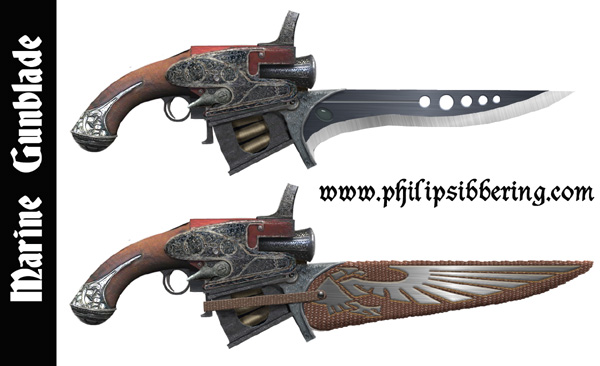
Belonging to Captain Squall of the Balamb Chapter of Space Marines - ops, wrong game 😀
Master Crafted Bolt pistol with combat accessory
Each Gunblade is considered a personal side arm and carried even when out of armour. Artificer Gunblades can only be carried by an officer (inc. Sergeants), and are a mark of high honour among the Space Marines. The passing of Chapter hero's Gunblade as part of a Space Marine's will to a fellow brother is considered a great honour, but they are only passed to those who do not already own one.
Note: Combat Accessories were in Rogue Trader, released 1987, and so 40K beats Final Fantasy to the punch on such weapons which first turn up in VIII released in 1997 - ten years later! I'm just reclaiming them
Connect
If you liked this, and would like to leave a comment on my guestbook, or catch up on all the recent comments, please visit my connect page. While there, you can also subscribe to email notifications, so you never miss a new post, along with my RSS feed as a backup. If you are feeling generous, and I know times are hard, you may support my site through Patreon (exclusive behind the scenes content), PayPal or Bitcoin! Lastly, there is a confidential contact form for any secret messages you wish to pass to me. Thank you for reading, and I look forward to hearing what you have to say :)

